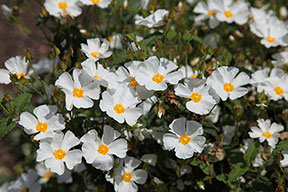 |
Previous Issues |
| Cedar Mill Community Website |
|
Search the Cedar Mill News: |
About The Cedar Mill News |
|
|||||||
| Volume 15, Issue 10 | October 2017 |
||||||
Good bets for fall planting: drought-tolerant trees, shrubs
|
||||
 |
Cistus, sometimes called Rock Rose, does well in dry summers |
Because our summers seem to be hotter and drier lately, planting drought-tolerant material will save water. There are more and better plants available now that tolerate drought conditions. Not familiar with these? Look for trees like redbud (Cercis), smoke tree (Cotinus); shrubs like Ceanothus, butterfly bush (none-seeding varieties), rock rose (Cistus); perennials such as daylilies, rudbeckia, penstemon, salvia, echinacea, sedums, and many herbs such as lavender. These are but a small taste of plants that tolerate drought. There are many more, and lists are available on websites, as well some local nurseries that specialize in these beauties.
All plants, drought-tolerant or thirsty, need to be watered regularly during the first year after planting so a healthy root system can develop. Drip irrigation or soaker hoses are ideal because the water is put efficiently near the roots and the soil surface remains dry, which keeps fewer weeds from sprouting. Hand watering is water-efficient but time-consuming for large areas. Watering deeply encourages roots to seek moisture at deeper levels. Mulching the soil holds moisture and prevents excessive evaporation.
When temperatures soar over 100 degrees, even drought tolerant plants may suffer. Temporarily shading plants during excessive heat helps to prevent damage. I keep shade cloth handy for my large pots of annuals. This is easier than moving them into shade until temperatures drop. My tomato plants seem to go dormant during very high temperatures, and they appreciate the relief.
Placement is a consideration with any plant. The south and west areas of our gardens are best for plants that thrive in hot, dry conditions. Adding a generous shovelful of compost to the planting hole helps to retain moisture and improve drainage—both important to establishing and maintaining healthy plants.
Consider plants that bloom in fall when others are finished for the year. My Autumn Joy and Autumn Fire sedums bloom in August and September, providing nectar for butterflies, which is especially important for those that are migrating now. If you haven’t tried some of these tough beauties you are in for a nice October surprise!
Questions? Email me at margierose2@gmail.com or call 503-645-2994.
![]()
Like us on Facebook for timely updates
Published monthly by Pioneer Marketing & Design
Publisher/Editor:Virginia Bruce
info@cedarmillnews.com
PO Box 91061
Portland, Oregon 97291
© 2017